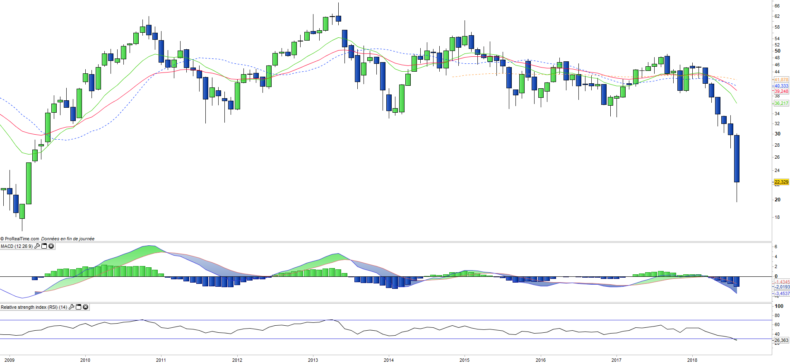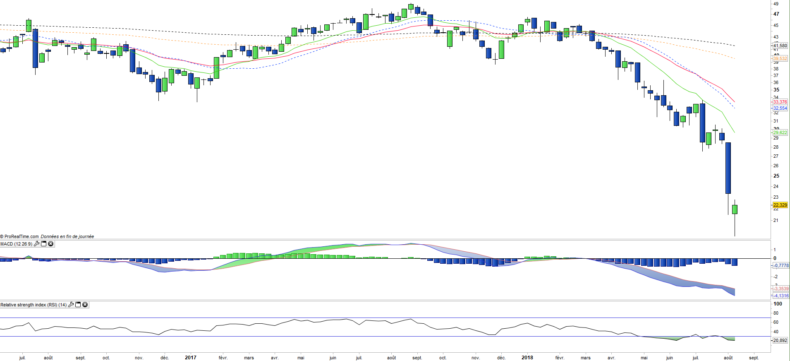Lyxor ETF Turkey - TUR - 15/08/2018
Short Term strategy: Negative (0%) / Tendance -
Long Term strategy: Negative (0%) / Tendance -
Characteristics of the ETF
The ETF TUR (Lyxor) created in 08/2006 replicates the Dow Jones Titan index of the 20 main Turkish securities with the largest capitalization and liquidity. The calculation method of the index limits the weighting of each security to 15%.
ETF fees are quite high compared to the average of our sample and reach 0.65% while AUM amount to 71M €. The replication method is indirect (via a swap) and the distribution policy is capitalized.
Alternative ETFs: TUR (iShares in USD)
Latest developments
The ETF TUR grew by 19.95% in 2017 despite the multiple tensions with its NATO’s partners and in the Middle East.
In 2018, the index recorded a dramatic fall of 50%, which is largely attributable to the decline of the Turkish lira attacked by the markets due to the anti-liberal economic policy of Mr Erdogan, which now attacks the independence of the Turkish Central Bank. This fall also corresponds to the distrust of the markets in front of an increasingly anti-Western policy, and mainly increasing tensions with the USA.
The decline in the turkish pound will increase the price of imports, primarily oil which may cause a further increase in inflation potentially devastating for the Turkish economy. Turkey seems to want to continue in its policy of confrontation with the US and the actions of the central bank seem to be insufficient to stop the negative spiral that seems to start.
The situation is very disturbing
Index & components
TUR replicates a narrow index that is very dependent on the financial sector which accounts for 32% of the capitalization, while the industry is the second sector with nearly 26%.
The index is highly correlated with the health of the Turkish economy, while energy represents only 8% of the index.
This tracker embeds the risk related to the Turkish lira, which can be quite erratic.
After double-digit growth for several years, the Turkish economy with a GDP of $ 720bn (17th in the world) suffered a slowdown at the beginning of the decade because of the unfavorable international environment: low growth in the area euro, the readjustment of US monetary policy, the Russian recession and the conflicts in Iraq and Syria. In addition, inside the country, there were political and security tensions that led to an authoritarian drift of President Erdogan which resulted in a considerable purge in the public and private spheres and could have long-term consequences. term.
The growth of the Turkish economy grew by 2.9% in 2016, a higher than expected figure, in a difficult political and security context, but significantly behind the 6.1% recorded in 2015. The levels of public debt and the deficit are low, but inflation remains above the 5% target set by the Central Bank. 2017 marks the return to sustained growth close to + 5% compared to 2016 due to the recovery in consumption.
Turkey, dependent on imports of intermediate goods for its production, has a trade deficit, despite a steady rise in exports, which have a relatively low value added. The country's economy remains linked to the recovery of the euro zone, a destination for one third of Turkish exports, and the political instability of the Middle East countries. The spearheads of Turkish foreign trade are the automotive and textile industries. Then come, in order, the agri-food sectors, machinery, electronic equipment, iron and steel and chemicals. The European Union is by far the largest customer of Turkey, followed by the United States, China and Iraq.
Historically (since 10 years), this tracker has been out of place in an area between € 15 and € 60 and an axis of symmetry around the € 32 level. Tensions and a possible break with the United States could change the destiny of Turkey in the medium term.
Monthly data
The monthly chart shows a vertiginous drop in the index (more than 50%) for 6 months, with the formation of a large candlestick in August that seems to characterize the heart of the decline. The residual bearish potential remains significant, because the next support is characterized by the 2008 bottom of 16 €. Apart from the extreme overselling of the oscillators, there is currently no favorable element that would indicate the end of the decline or a stabilization of the index.
Weekly data
On the weekly chart, we can observe the fall of the index which ensued soon after the crossing of the EMAs13 and 26 and the crossing of the major support of 32 €. A rebound is likely in the short term because of the extreme overselling of the oscillators but the downward pressure is such that it is difficult to envisage anything other than a continuation of the movement or at best a stabilization in the medium term.
ETF Objective
TUR is a UCITS ETF, listed in EUR, which seeks to replicate the Turkey DJ Titan 20 index (20 turkish companies)
Characteristics
| Inception date | 11/08/2006 |
| Expense ratio | 0,65% |
| Issuer | Lyxor |
| Benchmark | DJ Turkey Titans 20 |
| Ticker | TUR |
| ISIN | FR0010326256 |
| UCITS | Yes |
| EU-SD status | Out of scope |
| Currency | € |
| Exchange | Euronext Paris |
| Assets Under Management | 71 M€ |
| Dividend | Capitalization |
| PEA (France) | No |
| SRD (France) | Yes |
| Number of holdings | 20 |
| Risk | 4/5 |
Country Breakdown
| Turkey | 100% |
Sector Breakdown
| Financials | 32% |
| Industrials | 26% |
| Materials | 15% |
| Consumer staples | 9% |
| Energy | 8% |
| Telecom services | 6% |
| Consumer discretionary | 2% |
| Others | 2% |
Top Ten Holdings
| Eregli Demir Ve Celik Fabrik | 11% |
| Akbank T.A.S. | 9% |
| Bim Birlesik Magazalar AS | 9% |
| Koc Holding AS | 8% |
| Turkije Garanti Bankasi | 8% |
| Tupras Turkiye Petrol Rafine | 7% |
| Turk Hava Yollari | 7% |
| Turkcell iletism Hizmet AS | 6% |
| Haci Omer Sabanci Holding | 6% |
| Aselsan Elektronic Sanayi | 4% |


